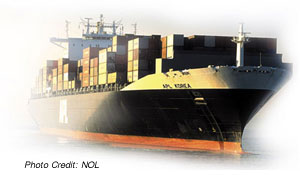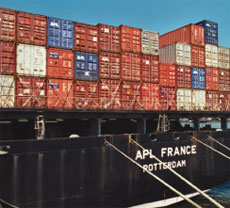|
by Robert BECKMAN

 he September 11, 2001 attack on the World Trade Center in New York triggered a series of actions by the international community to deal with the threat of maritime terrorism. In December 2002 the International Maritime Organization (IMO) adopted resolutions containing measures to strengthen maritime security and prevent acts of terrorism against international shipping. he September 11, 2001 attack on the World Trade Center in New York triggered a series of actions by the international community to deal with the threat of maritime terrorism. In December 2002 the International Maritime Organization (IMO) adopted resolutions containing measures to strengthen maritime security and prevent acts of terrorism against international shipping.
The IMO measures included the increased use by ships of Automatic Identification Systems and Ship Security Alert Systems. At the same time, the United States established the Container Security Initiative in order to diminish the threat posed by sea containers entering American ports.
These developments have triggered a response by private companies to develop innovative products that will meet the new maritime security requirements in a cost effective manner. Innovative companies are also developing logistics management software to help companies not only meet the new regulatory requirements, but at the same time improve inventory control and reduce administrative costs.
The new products and technologies have serious implications for ports, shipping companies, and companies involved in the logistics and supply chain business.
Automatic Identification Systems (AIS)
The Automatic Identification System (AIS) is a shipboard broadcast system that allows ships to easily track, identify, and exchange pertinent navigation information with other ships and with shore-based facilities. AIS systems work like a continuous and autonomous transponder, operating in the VHF maritime band. AIS systems are particularly useful in busy and congested shipping lanes like the Straits of Malacca and Singapore.
AIS technology relies on global navigation systems, navigation sensors, and digital communication equipment such as transponders. The AIS systems operate according to standardised communication protocols that permit the voiceless exchange of navigation information between vessels and shore-based vessel traffic centres.
AIS transponders on vessels automatically broadcast basic information about the vessel such as its identity, type, position, course, speed, navigational status, and other safety-related information. This information is received by AIS-equipped shore-based stations in its vicinity as well as by other ships and by aircraft that are equipped with AIS.
The IMO regulations requiring AIS systems on ships built after 2002 had been adopted prior to the September 11 incident. At its Conference on Maritime Security in December 2002, the IMO extended the requirements to smaller vessels that had been exempted under the earlier regulations.
Ports and coastal states will be better able to cope with the threat of maritime terrorism if AIS systems are utilised by all ships passing through their waters, including very small ships. Therefore, innovative companies have an incentive to develop inexpensive AIS systems that can be used by small vessels.
Ship Security Alert Systems and Long-Range Tracking (SSAS)
Under the measures adopted by the IMO in December 2002, all ships over 500 gross tonnes are required to be equipped with a Ship Security Alert System (SSAS), which is capable of discreetly raising the alarm to the relevant authorities and tracking the vessel if the security of the vessel is compromised, such as when it is attacked or hijacked.
 The intent of the ship security alert system is to send a covert signal or message from a ship that will not be obvious to anyone on the ship other than those who are aware of the alert mechanism. The procedures for the security alert are agreed with the ship's administration as part of the ship security plan and ideally should be individual to the ship. One security alert system device, Shiploc, has been endorsed by the International Maritime Bureau to deal with the threats of piracy and armed robbery against ships in Southeast Asia. The intent of the ship security alert system is to send a covert signal or message from a ship that will not be obvious to anyone on the ship other than those who are aware of the alert mechanism. The procedures for the security alert are agreed with the ship's administration as part of the ship security plan and ideally should be individual to the ship. One security alert system device, Shiploc, has been endorsed by the International Maritime Bureau to deal with the threats of piracy and armed robbery against ships in Southeast Asia.
Some companies are developing technology that will combine a ship security alert system with long-range tracking. The US Coast Guard has announced that it hopes to develop a long-range system to enable it to identify and track sea vessels headed towards the US. Other countries and companies are also likely to be interested in such technologies.
US Container Security Initiative (CSI)
The Container Security Initiative (CSI) was announced by the US in January 2002. Its purpose is to prevent terrorist attacks by identifying and examining containers that pose a risk before the containers are shipped to the US.
CSI consists of four core elements:
- intelligence and automated information to identify and target containers that pose a risk of terrorism;
- prescreening of containers that pose a risk at the port of departure before they arrive at US ports;
- detection technology to quickly prescreen containers that pose a risk; and
- smarter, tamper-evident containers.
The need to enhance the security of containers has triggered the need to develop innovative technology to secure containers and to track them during their passage. This has implications for ports and for everyone in the logistics and supply chain business.
Innovative companies are developing technology that will enable containers to be sealed electronically and monitored via satellite by computers. Security monitoring satellite communications equipment is installed inside the door of the container. The container door is sealed with a transponder after the security inspection has been completed. The container is then monitored from the point of deployment to the completion of the journey.
Maritime trade is a cornerstone of Singapore's economy, thus ensuring that its waters and port are safe is a key priority. To assist the industry in this critical area, the Centre for Maritime Studies at the National University of Singapore plans to conduct research on these security developments.
 Click here to download the full issue for USD 6.50 Click here to download the full issue for USD 6.50
|



 he September 11, 2001 attack on the World Trade Center in New York triggered a series of actions by the international community to deal with the threat of maritime terrorism. In December 2002 the International Maritime Organization (IMO) adopted resolutions containing measures to strengthen maritime security and prevent acts of terrorism against international shipping.
he September 11, 2001 attack on the World Trade Center in New York triggered a series of actions by the international community to deal with the threat of maritime terrorism. In December 2002 the International Maritime Organization (IMO) adopted resolutions containing measures to strengthen maritime security and prevent acts of terrorism against international shipping.
 The intent of the ship security alert system is to send a covert signal or message from a ship that will not be obvious to anyone on the ship other than those who are aware of the alert mechanism. The procedures for the security alert are agreed with the ship's administration as part of the ship security plan and ideally should be individual to the ship. One security alert system device, Shiploc, has been endorsed by the International Maritime Bureau to deal with the threats of piracy and armed robbery against ships in Southeast Asia.
The intent of the ship security alert system is to send a covert signal or message from a ship that will not be obvious to anyone on the ship other than those who are aware of the alert mechanism. The procedures for the security alert are agreed with the ship's administration as part of the ship security plan and ideally should be individual to the ship. One security alert system device, Shiploc, has been endorsed by the International Maritime Bureau to deal with the threats of piracy and armed robbery against ships in Southeast Asia.
 Click here to download the full issue for USD 6.50
Click here to download the full issue for USD 6.50